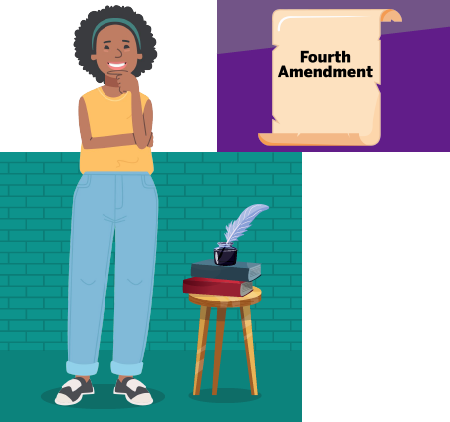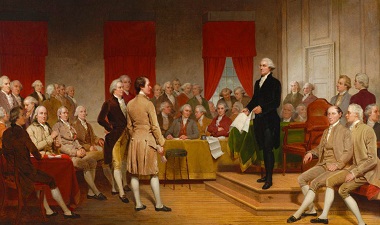
Getting Started
This module includes an Unboxing the Constitution video (5 min), Inside the Constitution video (8 min), student activities, and a learning project. Download the Teachers Guide and the Student Content Guide for more details on content and implementation. Course materials are provided in Google documents, Word documents, as well as printable PDFs.
A preview of the module can be accessed below.
Topics covered include:
- Defining key terms about the Fourth Amendment
- Exploring expectations of privacy
- Diving into the history of the Fourth Amendment
- Reviewing landmark Supreme Court cases

Vocabulary
At the beginning of each module, students are presented with vocabulary words and definitions.
Concept Words
Concept words are conceptually related to the big ideas in what they’re learning. These connect directly to the core concepts or themes of the lesson or unit and help students grasp the main ideas and how everything fits together
- exclusionary rule: a rule that says evidence collected by the police in an illegal way can’t be used in court
- probable cause: a fact- and reason-based belief by the police that a crime has occurred
- third-party doctrine: a rule that says if you share information with a company (the third party), you lose some privacy rights over that information
- Writ of Assistance: an old form of warrant; one that was very broad
- evidence: information or objects that help prove a person is guilty or innocent
- privacy: the right to keep your personal information and belongings safe from being seen or taken by others
- reasonable: fair and sensible
- search: the act of looking through someone’s property
- seizure: the act of taking someone’s property
- surveillance: watching or listening to another for the purpose of gathering information
- warrant: legal authorization from a judge allowing the police to perform a search

Topic 1: The Fourth Amendment and "Unreasonable" Searches
In most cases, the government—including police officers—must have a specific reason to believe you’ve broken the law before it can search your property or take your belongings. This principle is the foundation of the Fourth Amendment’s warrant requirement, which ensures that searches and seizures are based on particularized suspicion rather than broad, unchecked power. By looking closely at the origins of the Fourth Amendment and how it applies today, we can better understand its impact on our rights and freedoms.
11.1: Activate Prior Knowledge
What are some myths and facts about the Fourth Amendment? Students will consider the things they know, and some things they think they know, about the amendments and its protections in this Fourth Amendment Myths or Facts activity.
Unboxing the Constitution
In this Unboxing the Constitution video, Lucy defines key terms from the Fourth Amendment and explores some Supreme Court cases that have included constitutional questions around the amendment.
11.2: Can They Do That?
What is privacy? What is a search? What is a seizure? Students will define key terms and explore key concepts from the Fourth Amendment.
11.3: What is Reasonable?
Students will engage with different scenarios to consider: What is a reasonable expectation of privacy?
11.4: Closing Activity
Students will check in on the Key Question(s).

Topic 2: Technology and Unreasonable Searches
When the Fourth Amendment was written, searches and seizures mostly involved physical spaces like homes, papers, and personal belongings. But as technology has advanced, so has the way the government collects information, raising new questions about what constitutes an unreasonable search and seizure.
11.5: History of the Fourth Amendment
In this Inside the Constitution video, students will use the Fourth Amendment History handout as Jeff and Lucy answer big questions related to the Fourth Amendment, including: What are some important people, events, and court cases that helped shape the understanding of the Fourth Amendment over time?
Inside the Constitution
11.6: Civic Connection: Fourth Amendment Case Review
In this Civic Connection activity, students will review a landmark Supreme Court case that involves questions around the Fourth Amendment.
11.7: Reflect
Students will revisit the KWL handout from the Activate Prior Knowledge handout to see how insights have grown throughout the lesson.

Learning Project: Privacy Posters: Know Your Fourth Amendment Rights
In this activity, students will create a Know Your Rights poster to educate others about their Fourth Amendment protections. Understanding their rights—and the limits on those rights in certain places, like schools—helps students recognize how the Fourth Amendment protects their privacy while also allowing for reasonable restrictions in specific settings, empowering them to navigate real-world situations with confidence and awareness.













